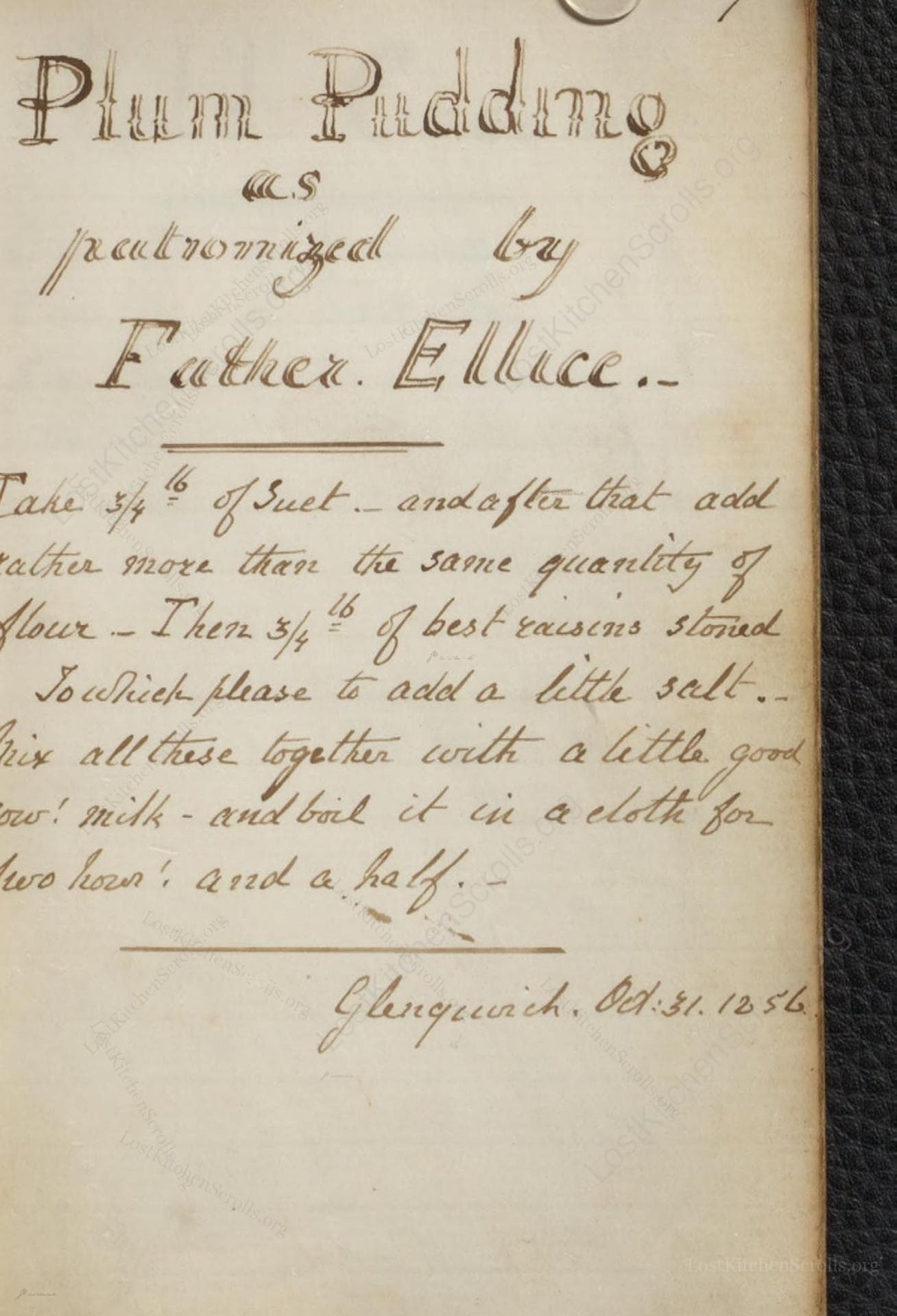Plum Pudding As Patronized By Father Ellice.-
From the treasured pages of Recipe book of Charles Ellice, Colonel, 24th Regiment
Written by Charles Ellice, Colonel

Plum Pudding As Patronized By Father Ellice.-
"Take 3/4 lb of Suet.. and after that add rather more than the same quantity of flour - Then 3/4 lb of best raisins stoned To which please to add a little salt. - Mix all these together with a little good cow' milk - and boil it in a cloth for two hours and a half. - Glenguick. Oct. 31. 1856"
Note on the Original Text
The recipe is written in the charmingly terse, conversational style typical of Victorian manuscript cookbooks—assumptions are made about the cook’s kitchen knowledge and the availability of ingredients. Spellings (like 'suet', 'recover', or the phrase 'best raisins stoned') and phraseology reflect the period, and imperial measurements are used as standards. No exact temperatures or quantities of liquid are given, relying on intuition and experience—skills a 19th-century housekeeper or cook would wield with confidence.

Title
Recipe book of Charles Ellice, Colonel, 24th Regiment (1856)
You can also click the book image above to peruse the original tome
Writer
Charles Ellice, Colonel
Era
1856
Publisher
Colonel Charles Ellice
Background
A charming manuscript cookbook chronicling the culinary escapades of Colonel Charles Ellice during his globe-trotting military career, featuring recipes from Highland butter to yeastless bread, spicy curries, and even a dash of Victorian medicine—all penned alongside evocative ink sketches and a personal index.
Kindly made available by
McGill University
This recipe hails from the hand-written cookbook of Colonel Charles Ellice, created during his career as a British Army officer in the mid-19th century. Ellice's travels—most notably in Highland Scotland and colonial India—are reflected in a varied culinary collection, ranging from British staples like puddings to more exotic foods and even medicinal concoctions. The manuscript, dating from 1856 and beyond, captures the day-to-day foodways of an officer and his household, offering a fascinating look at both the continuity and adaptation of British comfort dishes abroad.

In the 1850s, cooks would prepare this pudding with a sturdy butcher’s knife for chopping suet, a large mixing bowl for blending ingredients, and a pudding cloth—usually a well-floured piece of linen or muslin—to wrap the pudding for boiling. A large cauldron or heavy-bottomed pot set over an open hearth or kitchen range would be filled with boiling water, into which the pudding was placed for its lengthy simmer. Twine was used to secure the cloth, ensuring the batter stayed compact during cooking.
Prep Time
20 mins
Cook Time
2 hrs 30 mins
Servings
8
We've done our best to adapt this historical recipe for modern kitchens, but some details may still need refinement. We warmly welcome feedback from fellow cooks and culinary historians — your insights support the entire community!
Ingredients
- 12 oz beef suet (finely chopped; vegetarian suet as substitute)
- 13 oz plain flour (slightly more than suet)
- 12 oz raisins (stoned; substitute sultanas or currants if needed)
- Pinch of salt
- Whole milk (enough to bind, approx. 5 fl oz)
Instructions
- To make Father Ellice’s Plum Pudding in a modern kitchen, begin by finely chopping 12 ounces of beef suet.
- Combine this with about 13 ounces of plain flour—just a bit more than the weight of suet.
- Add 12 ounces of the best available raisins, making sure to remove their stones first, and sprinkle in a good pinch of salt.
- Stir everything together, then moisten with a splash of fresh cow's milk (or whole milk), just enough to bind the mixture into a thick, somewhat cohesvive dough.
- Shape the mixture into a tight ball and wrap it securley in a pudding cloth or a large square of muslin, tying it firmly with kitchen twine.
- Place it in a pot of boiling water, ensuring the water covers the pudding, and simmer for 2.5 hours.
- Unwrap and serve warm.
Estimated Calories
370 per serving
Cooking Estimates
Preparing the suet, flour, raisins, and forming the pudding takes about 20 minutes. Cooking is mostly hands-off and takes around 2.5 hours. Each slice of this traditional pudding is estimated to have about 370 calories. The full recipe serves 8 people.
As noted above, we have made our best effort to translate and adapt this historical recipe for modern kitchens, taking into account ingredients nowadays, cooking techniques, measurements, and so on. However, historical recipes often contain assumptions that require interpretation.
We'd love for anyone to help improve these adaptations. Community contributions are highly welcome. If you have suggestions, corrections, or cooking tips based on your experience with this recipe, please share them below.
Join the Discussion
Rate This Recipe

Den Bockfisch In Einer Fleisch Suppen Zu Kochen
This recipe hails from a German manuscript cookbook compiled in 1696, a time whe...

Die Grieß Nudlen Zumachen
This recipe comes from a rather mysterious manuscript cookbook, penned anonymous...

Ein Boudain
This recipe comes from an anonymous German-language manuscript cookbook from 169...

Ein Gesaltzen Citroni
This recipe, dating from 1696, comes from an extensive anonymous German cookbook...
Browse our complete collection of time-honored recipes



